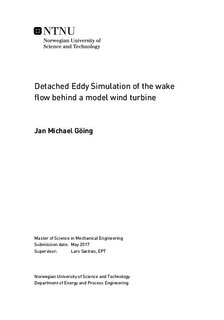Detached Eddy Simulation of the wake flow behind a model wind turbine
Master thesis
Permanent lenke
http://hdl.handle.net/11250/2454906Utgivelsesdato
2017Metadata
Vis full innførselSamlinger
Sammendrag
In times of renewable energy the planning of wind parks and the improvementof the total efficiency has become a major field of research. In order to the optimalpositioning of a wind cluster a precise analysis of the wake properties behind a tur-bine is necessary. Due to the increasing computer performance, numerical modelshave become an important tool for the precise analysis of the turbulent wake flow.In this study the wake characteristics are calculated with a Delayed - Detached- Eddy - Simulation (DDES) using a sliding mesh technique. The simulation isbased on a model wind turbine with a diameter of 0.89 m and a test area whichcorresponds to the wind tunnel geometry of the department of energy and processengineering from the NTNU. A validation of DDES with an experimental Laser- Doppler - Anemometry (LDA) matches well with the results. The simulationcalculates the velocity components and the turbulence kinetic energy sufficientlyaccurate. In addition, the coherent structure of a vortex shedding and a significantfrequency at 1p in the near wake is located with a Proper - Orthogonal - Decompo-sition. The final part of this report shows the trajectory of the same turbine witha yaw angle of γ = 30◦. The simulation is based on the same numerical conditionsand describes an unexpected trajectory of the velocity deficit.
